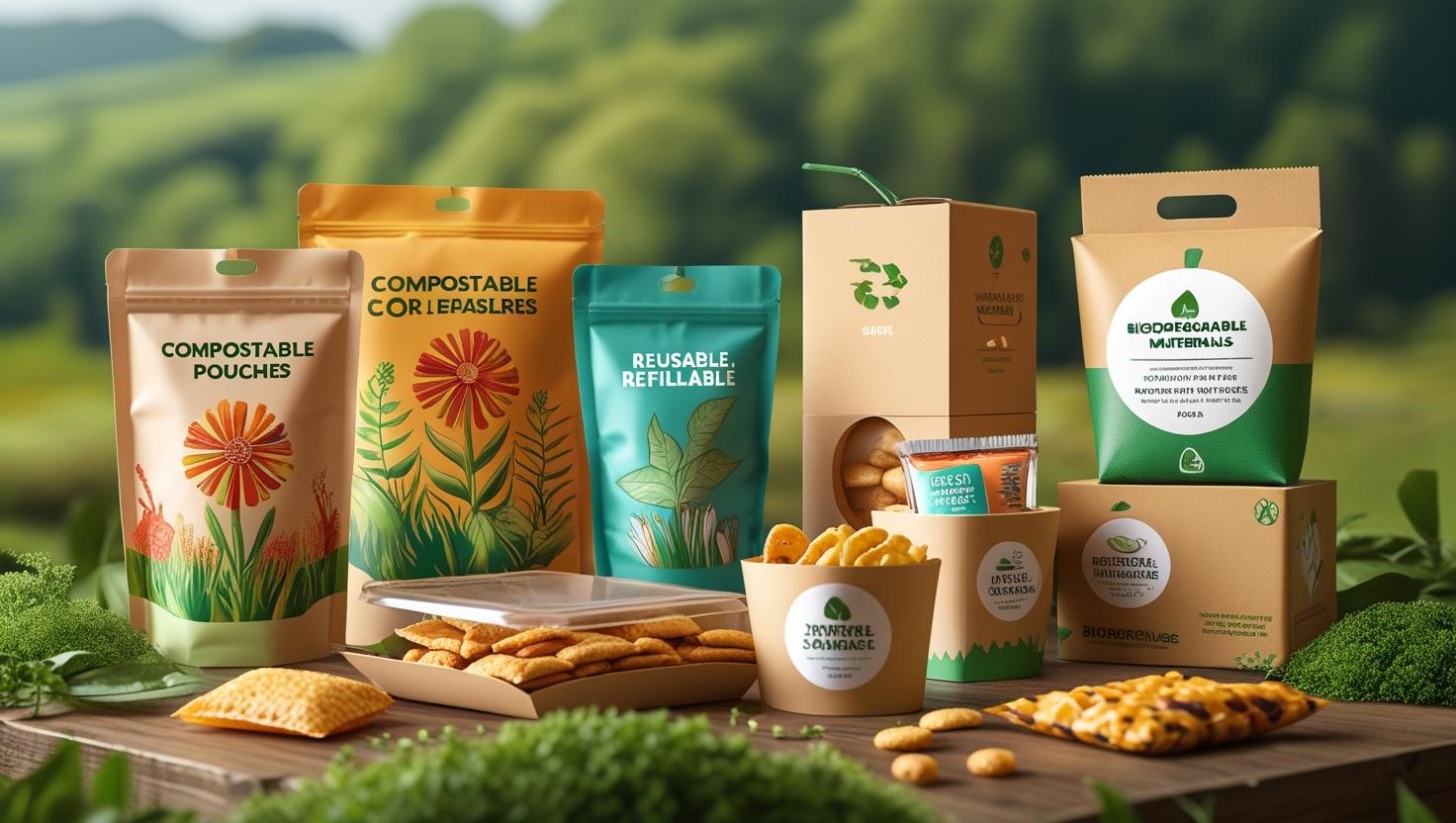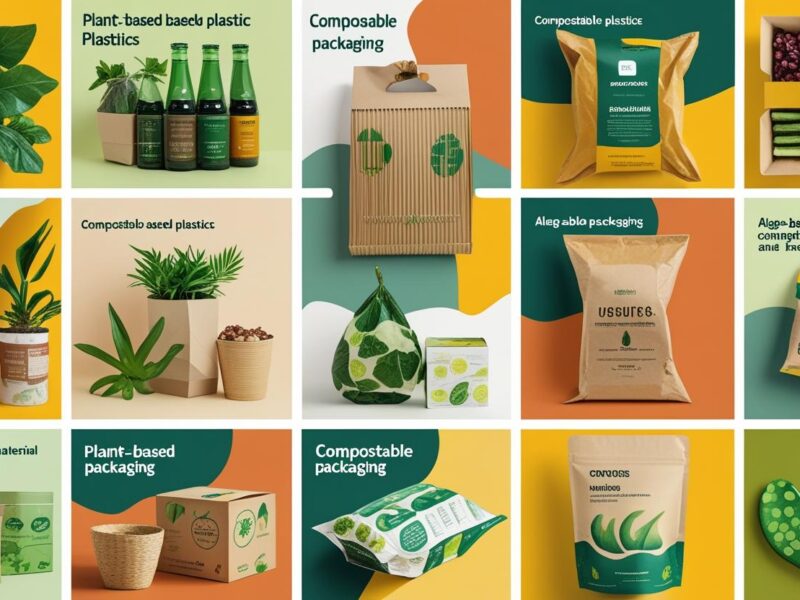Discover eco-friendly and sustainable snack packaging solutions that reduce waste and protect the environment. Learn about trends, materials, and benefits.
In an era where sustainability is more important than ever, businesses and consumers are both becoming more conscious of the environmental impact of their choices. Snack packaging, a crucial part of the food industry, has traditionally been linked to excessive waste and non-recyclable materials. However, with the growing demand for eco-friendly solutions, the snack packaging industry is undergoing a significant transformation.
This article explores the importance of sustainable snack packaging, its benefits, and the latest trends in eco-friendly materials and designs. Whether you’re a business owner, a product manufacturer, or a consumer looking to make greener choices, this comprehensive guide will offer valuable insights into the world of sustainable snack packaging.

Understanding the Importance of Sustainable Snack Packaging
The rise of environmental awareness and climate change concerns has brought sustainability to the forefront of modern life. Snack packaging, particularly single-use plastics, has long been a significant contributor to the growing waste crisis. According to reports, the global packaging industry is expected to produce millions of tons of plastic waste annually. As the demand for convenience snacks increases, so does the need for more sustainable and environmentally friendly packaging solutions.
Sustainable packaging reduces the environmental footprint, encourages recycling, and helps preserve natural resources. It also helps businesses comply with increasingly strict regulations regarding waste and plastic use. By shifting to sustainable packaging options, companies contribute to a cleaner planet and appeal to environmentally-conscious consumers.
What is Sustainable Snack Packaging?
Sustainable snack packaging refers to packaging materials and designs that are environmentally friendly, minimizing waste, reducing reliance on non-renewable resources, and promoting recyclability. These packaging solutions prioritize the health of the environment while maintaining the functionality and aesthetic appeal required in the snack industry.
Key Features of Sustainable Snack Packaging
- Biodegradability: Packaging that breaks down naturally without harming the environment.
- Recyclability: Materials that can be recycled and reused, reducing landfill waste.
- Compostability: Packaging that decomposes into nutrient-rich soil when disposed of properly.
- Use of Renewable Resources: Materials sourced from renewable resources, such as plants or biodegradable materials.

Types of Sustainable Snack Packaging Materials
The packaging industry is rapidly evolving, with companies exploring various materials that contribute to a more sustainable future. Here are some of the most popular materials used in sustainable snack packaging:
Plant-Based Plastics
Made from renewable plant resources such as corn, sugarcane, and potato starch, plant-based plastics offer a more sustainable alternative to conventional plastic. These biodegradable materials break down over time, reducing waste and environmental damage.
Paper and Cardboard
Paper and cardboard are some of the most sustainable packaging materials. These materials are made from renewable resources and are easily recyclable. Paper and cardboard packaging also have the advantage of being lightweight, reducing transportation costs and emissions.
Glass and Metal
Glass and metal are sustainable alternatives to plastic. Both materials are highly durable, reusable, and recyclable. Glass is often used for packaging high-end snacks, while metal, such as aluminum, is commonly used for snack tins and containers.
Compostable Films
Compostable films, made from renewable resources like cornstarch, are a great option for snack packaging. These films decompose naturally in composting environments, reducing the strain on landfills and helping to enrich soil.
Edible Packaging
An exciting innovation in sustainable packaging, edible packaging is made from ingredients such as seaweed or rice. This type of packaging can be consumed along with the snack, eliminating waste altogether.

The Benefits of Sustainable Snack Packaging
Adopting sustainable snack packaging offers several benefits, both for businesses and the environment. Here are some of the most notable advantages:
Environmental Impact Reduction
Sustainable packaging reduces the environmental burden by using renewable resources and decreasing reliance on fossil fuels. Additionally, biodegradable and compostable packaging materials contribute to waste reduction and prevent pollution.
Cost-Effective Solutions
While the initial investment in sustainable packaging may be higher, over time, companies can save money on waste management, disposal costs, and potentially reduced taxes on non-compliant packaging materials. Moreover, sustainable packaging can improve brand loyalty and attract environmentally conscious customers.
Compliance with Regulations
As governments around the world introduce stricter regulations on single-use plastics and waste management, sustainable snack packaging ensures compliance. This helps companies avoid penalties and enhances their reputation as environmentally responsible businesses.
Consumer Appeal
Today’s consumers are increasingly concerned about environmental issues, and they are more likely to support brands that adopt sustainable practices. Offering eco-friendly packaging can boost consumer trust, loyalty, and brand value.

Emerging Trends in Sustainable Snack Packaging
The sustainable packaging industry is constantly evolving, and new trends are emerging to meet consumer demands for environmentally-friendly solutions. Here are some notable trends to watch in the coming years:
Minimalist and Simple Designs
Sustainability isn’t just about the materials used; it’s also about the design. Many snack brands are adopting minimalist packaging designs that use fewer materials while still maintaining an attractive and functional package.
Smart Packaging
With advancements in technology, smart packaging is becoming more common in the snack industry. These packaging solutions use sensors, QR codes, or NFC (Near Field Communication) technology to provide consumers with more information about the product’s sustainability, recycling instructions, and supply chain transparency.
Refill and Reuse Programs
Snack brands are increasingly offering refillable or reusable packaging options. Instead of buying single-use snack packs, consumers can purchase larger, eco-friendly containers that can be refilled, reducing packaging waste significantly.
Biodegradable Coatings
Snack packaging often uses coatings to ensure product freshness. Traditional coatings are made from harmful chemicals, but biodegradable coatings are now being developed from natural materials like plant-based oils and starches. These coatings can be safely composted along with the rest of the packaging.
How Brands are Leading the Way
Many major brands have already adopted sustainable packaging solutions, and their efforts provide valuable lessons for others in the industry.
Unilever’s Commitment to Sustainable Packaging
Unilever has committed to making all of its plastic packaging recyclable, reusable, or compostable by 2025. The company is also working towards reducing its plastic packaging use by a third.
Nestlé’s Focus on Recycling
Nestlé has been pioneering sustainable packaging in the snack industry, with a focus on increasing the use of recyclable materials and reducing the use of plastics in its packaging.
PepsiCo’s Eco-Friendly Packaging Initiatives
PepsiCo has set ambitious goals for sustainability, aiming to make 100% of its packaging recyclable, compostable, or biodegradable by 2025. The company has also committed to reducing the use of virgin plastic in its packaging.
Overcoming Challenges in Sustainable Snack Packaging
While sustainable snack packaging offers numerous benefits, it also comes with challenges. These challenges include higher production costs, limited availability of eco-friendly materials, and consumer resistance to change. However, businesses can overcome these obstacles by:
- Educating consumers about the importance of sustainable packaging and encouraging them to participate in recycling programs.
- Collaborating with packaging suppliers to develop innovative and cost-effective eco-friendly materials.
- Investing in research and development to create new packaging technologies that meet both sustainability goals and consumer demands.
How Consumers Can Make a Difference
Consumers also play a significant role in driving the adoption of sustainable snack packaging. Here are some ways individuals can contribute:
- Support brands that use eco-friendly packaging materials.
- Recycle properly to ensure that packaging is disposed of in an environmentally responsible way.
- Reduce consumption of single-use plastics by choosing snacks with minimal or recyclable packaging.
Frequently Asked Questions
1. Why is sustainable snack packaging important?
Sustainable snack packaging helps reduce waste, conserve natural resources, and decrease pollution. It also aligns with growing consumer demand for eco-friendly products.
2. Is edible packaging safe to consume?
Yes, edible packaging made from materials like seaweed or rice is safe to consume. It is designed to be both environmentally friendly and consumable.
3. Can sustainable snack packaging help reduce costs for businesses?
While the initial investment may be higher, sustainable packaging can lead to long-term savings in waste disposal, improve brand reputation, and attract environmentally-conscious customers.
4. What are the environmental benefits of plant-based plastics?
Plant-based plastics are biodegradable, reducing landfill waste and pollution. They are made from renewable resources, which helps reduce reliance on fossil fuels.
5. How can consumers support sustainable snack packaging?
Consumers can choose products with eco-friendly packaging, recycle responsibly, and support brands that prioritize sustainability.
Conclusion
Sustainable snack packaging is not just a trend; it is a critical step towards reducing waste and protecting the environment. With a variety of eco-friendly materials, innovative designs, and emerging technologies, the snack industry is becoming more sustainable every day. By making informed choices and supporting brands that prioritize sustainability, both businesses and consumers can contribute to a greener planet. It’s time to embrace sustainable packaging and pave the way for a more eco-conscious future.


